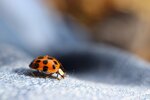Moderate fall temperatures are quickly turning into frigid days and nights in Alabama. Record lows and freeze watches are driving people — as well as bugs — inside homes and structures to …
This item is available in full to subscribers.
Please log in to continue |



Moderate fall temperatures are quickly turning into frigid days and nights in Alabama. Record lows and freeze watches are driving people — as well as bugs — inside homes and structures to stay warm. However, most people don’t take kindly to these unwanted guests. Like them or not, Alabama Cooperative Extension System home grounds, gardens and home pests experts say this time of year is prime time for home invaders.
Creature Comforts
Meredith Shrader, an Alabama Extension entomologist and lead diagnostician at the Auburn University Plant Diagnostics Laboratory, said people and insects share a trait or two.
“Like you and I like a cozy environment, they (insects) too are seeking shelter for the winter,” Shrader said in a recent episode of Alabama Extension’s “From the Ground Up!” podcast. “They don’t want to be left out in the cold like we don’t, so they’re trying to find an environment where they can hunker down, go to sleep and get through the worst of it.”
Many times, these sanctuaries are people’s homes. Shrader said the big three of the most common pests that she receives reports of are the Asian multicolored ladybug, brown marmorated stink bug and kudzu bug. Insects see structures as a beacon for survival, therefore making every nook and cranny appealing.
Stacking firewood against a home is also an attractive landing spot for bugs and may promote the transfer of unwanted species, such as termites. Consider the placement of portable structures or insulated materials, as they may serve as a temporary home for other creatures as well.
Augmenting Your Environment
According to Shrader, augmenting your environment is one of the best defenses for home invaders.
“I try to tell people that there's not necessarily a spray or anything that will prevent them from getting in your home,” Shrader said. “It's more of an environmental step that you have to take to augmenting your environment to make it less habitable for them.”
Preventative changes like sealing cracks in house sidings, fixing door sweeps and replacing worn weather stripping can create a no-fly zone to keep bugs away. The pest solution directly relates to the problem insect species.
“I’m all for sprays,” Shrader said. “I think sprays are another tool in your toolkit. However, because of the price tag of some products, some sweat equity is your best first line of defense.”
Positive Identification
Not all insecticides have the same effect. Some products aim to treat a specific species. So, simply spraying directly on bugs or areas where there are bugs may not accomplish the task. Shrader said it is critical for anyone with an insect problem to first submit a specimen to the Auburn University lab or visit their county Extension office for identification. If someone doesn't identify a pest, then a proper plan of treatment will be difficult to implement.
“You go out and spend $50 on something, spray it and then find out a week or two later — when you still have the issue — that the product wasn't effective, so now you have to go and get something else,” Shrader said. “So, now you’re at $100 when you could have could have stopped it or cut it off a little sooner by getting an identification and then a proper product.”
It is also not ideal to wage an all-out war on certain insects that are not worth the expense. A person must decide whether it is necessary to eradicate a species, such as ants, who are resilient and could come back in a short amount of time.
“People want to get rid of everything and it just becomes, ‘well, how many hours a week are you going to invest in trying to get rid of these ants or pavement ants that are, you know, harmless?’,” Shrader said. “Or how much money do you want to spend on trying to get rid of the ants that'll be back in two weeks?”
She also said as soon as insects get inside a home, it becomes necessary to eliminate the pest. However, risks and cost should always be the deciding factor when choosing to address a cool-month pest problem.
Contact Extension
The best solution to kicking out home invaders this winter is utilizing science-based resources from Alabama Extension. Reach out to your local Extension office to learn more about your invaders and the best ways to prevent them from moving in permanently.
Contact the Auburn University Plant Diagnostics Laboratory to inquire about positive pest identification.